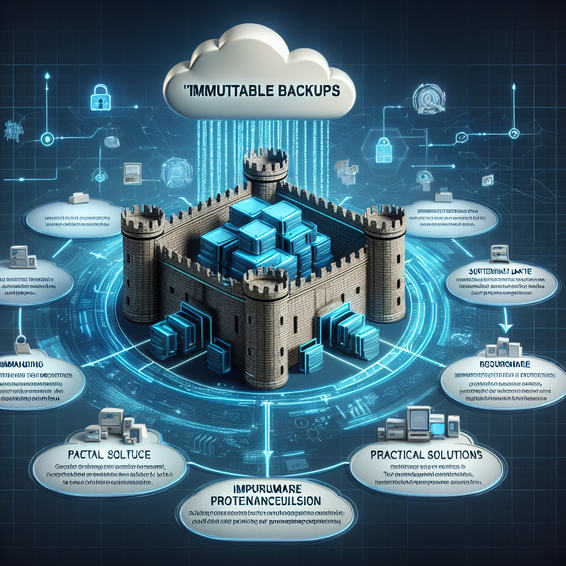There’s no way to sugarcoat it: if you’re still relying on traditional modifiable backups, you’re betting your business on luck. As ransomware attacks climb—according to Veeam’s 2025 Ransomware Trends report, 69% of organizations were hit by ransomware in the past year—the only line between data recovery and devastating loss is often a well-designed immutable backup strategy. This isn’t just recommended; it’s become non-negotiable for cyber resilience, regulatory compliance, and operational sanity.
Why Immutable Backups Are Non-Negotiable
Immutable backups are fundamentally different from conventional backups. Once written, data can’t be altered or deleted for a set retention period—not by hackers, insiders, or even admins. This is achieved through Write Once, Read Many (WORM) technology, and rock-solid policy enforcement at both hardware and software levels. The upshot? When ransomware strikes, attackers can’t encrypt or erase your backups, slamming the door on ransom demands and business-ending data loss. N2W and Veeam both offer native support for these immutable backups, layering in crucial features like retention windows and cross-cloud restores.
From a business and IT perspective, here’s why immutability should be at the top of your agenda:
- Defense Against Ransomware: If your immutable backup can’t be modified, it can’t be ransomed. It’s that simple.
- Compliance and Auditability: Frameworks like HIPAA and GDPR often require immutable storage. Having immutable, auditable recovery points makes passing compliance checks and reducing insurance premiums easier.
- Rapid Recovery: After a ransomware attack, immutable backups provide pristine data for lightning-fast recovery—no debate, no haggling with criminals.
- Reduced Risk of Insider Threats: Even privileged accounts can’t override immutable retention windows, cutting off another major risk vector.
The impact on organizations is profound. Costs go up slightly due to locked retention periods and management complexity, but these pale in comparison to a single attack’s ransom or regulatory fine. For IT and business leaders, the value proposition is crystal clear: immutable storage is the backbone of business continuity, cyber insurance, and executive peace of mind. For a deeper dive on real impacts to business continuity and response, check out this analysis of IT outages and recovery lessons, or learn more about data breaches’ business impact here.
Key Analysis & Lessons Learned
Organizations who’ve ignored immutable practices have paid dearly—lost revenue, disrupted operations, shattered reputations, and regulatory heat. In sectors with high data integrity requirements—critical infrastructure, finance, healthcare—immutable storage isn’t just best practice; it’s now a baseline expectation.
- Immutability Period is Everything: Too short, and you lose rollback options. Too long, and storage costs spiral. Always align with business SLAs and risk profiles.
- Combining Immutability with Air-Gapping: A best-in-class backup strategy combines immutable storage with offsite, even air-gapped, copies for true disaster resilience.
- Continuous Monitoring and Testing: Never assume backups are safe—frequent automated validation, test recoveries, and alerting are essential to ensure you don’t discover holes during a crisis.
On the vendor side, not all so-called “immutable” solutions are actually enforced or standards-compliant. Demand due diligence from your backup and storage vendors—look for WORM enforcement, strong policy validation, integrated auditing, and wide ecosystem integration. If you’re interested in the dynamic between backup immutability and overall security strategy, see my guide on business security against modern attacks.
Actions, Technologies & Solutions for IT Pros
Here’s how smart IT professionals can take control, cut risk, and gain true resilience:
- Follow the 3-2-1-1-0 Backup Rule: Three copies of data, two media types, one offsite, one offline/immutable, zero restore errors.
- Choose Platforms with Native Immutability: Both Veeam, N2W, and Acronis offer robust immutable backup strategies for physical, virtual, cloud, and SaaS environments.
- Automate Validation & Monitoring: Use tools like Veeam’s SureBackup or policy monitoring from major backup vendors to constantly verify the integrity—and immutability—of your backups.
- Enforce Strong Access Controls: Role-Based Access Control (RBAC), encryption in transit/rest, and documented audit trails are must-haves.
- Test Real-World Restores Regularly: Don’t just run simulations—initiate real restores and validate that immutability works under pressure. Document every result.
For cost efficiency, consider deduplication appliances, tiered object storage, and leveraging cloud-native WORM features to manage storage spend while keeping compliance and resilience intact. Best-in-class solutions currently include Veeam Data Cloud Vault, AWS S3 Object Lock, hardened Linux repos, and Acronis Cyber Protect—with all providing multi-layered protection, scalable storage, and integrated regulatory compliance.
Don’t forget to integrate immutable backups into your broader cyber recovery plan and incident response playbooks. As threats evolve, routinely review and update retention policies, onboard new automation tools, and stay current on ransomware TTPs (tactics, techniques, and procedures). For more advanced strategies and cyberattack lessons, review my breakdown of current security best practices.
Conclusion: Immutability is Non-Negotiable
Ransomware, insider threats, and costly downtime aren’t unique to large enterprises—they’re everyone’s problem now. With immutable backups, you’re not just building a technical control, you’re locking in business continuity and credibility. Treat immutability and cyber resilience as strategic investments, not just technical tools. The organizations who survive and thrive in the face of inevitable attacks are the ones who take backup immutability seriously—and execute it with discipline.
